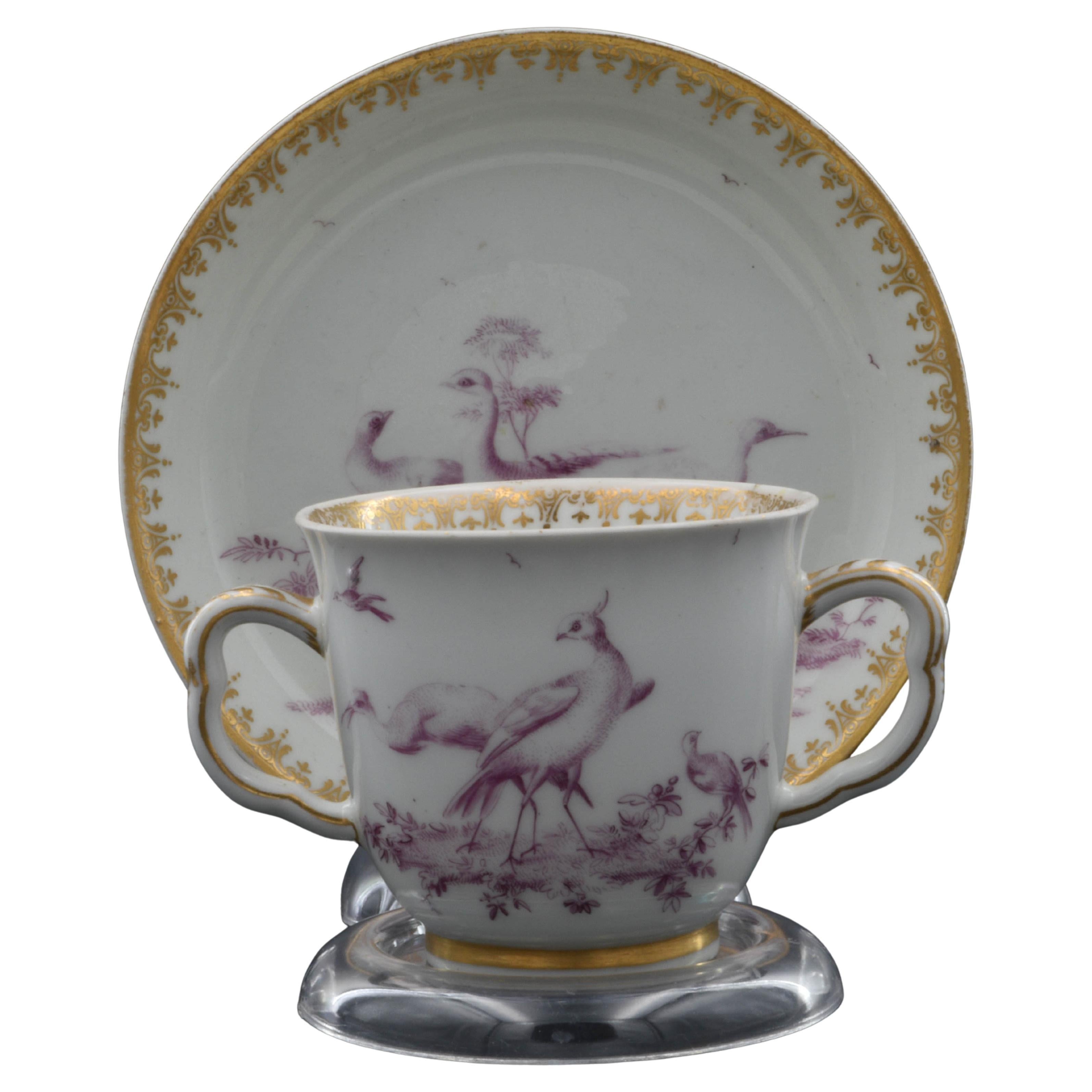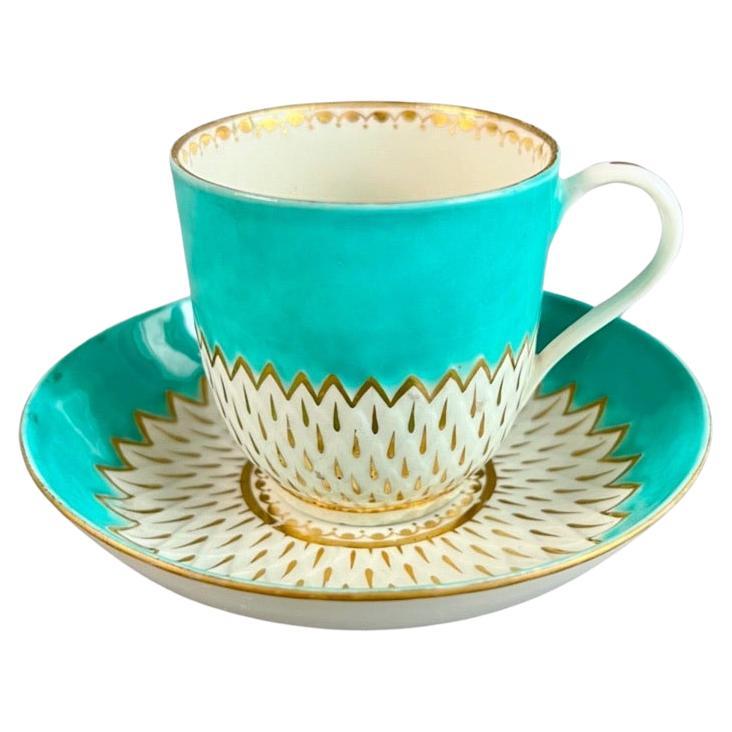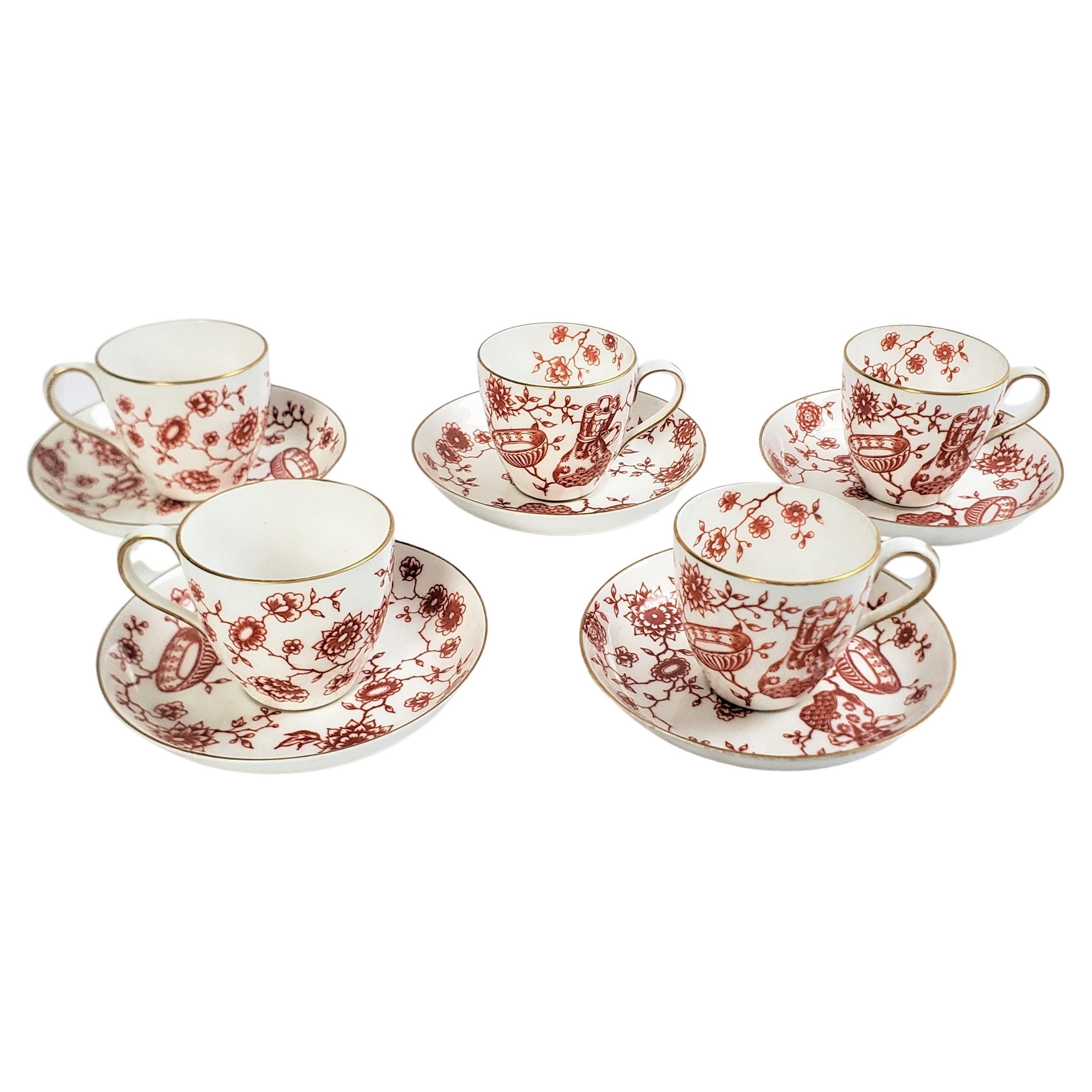Items Similar to Chelsea-Derby Chocolate Cup Set, Gilt Stripes, Puce Flowers, Rococo 1770-1775
Want more images or videos?
Request additional images or videos from the seller
1 of 16
Chelsea-Derby Chocolate Cup Set, Gilt Stripes, Puce Flowers, Rococo 1770-1775
About the Item
This is a beautiful chocolate cup set made by Chelsea-Derby between 1770 and 1775, which was the Rococo era. The set consists of a cup, a saucer and a cover, and is decorated in a stunning style with slightly psychedelic gilt stripes and elegant puce flowers.
The Derby Porcelain factory has its roots in the late 1740s, when Andrew Planché, a Walloon Huguenot refugee, started making simple porcelain toys shaped like animals in his back yard. In 1756 Staffordshire enameller William Duysbury and banker John Heath started a new porcelain factory with Planché and this was to grow out to the largest factory of its time, buying up the bankrupted Chelsea and Bow factories, as well as the stock of several other workshops including that of James Giles. The combination of various traditions, porcelain making skills and sophisticated clients enabled Duesbury to create one of the best porcelain factories of the 18th and 19th Centuries, which after many ups and downs is still operative today. The period between 1770 and 1784 is often called the "Chelsea-Derby" period, as both factories worked alongside each other under the leadership of Duesbury. This cup is from this period.
Chocolate cups were to feed well-to-do ladies while being helped by their servants with their toilette. In the age of complicated dresses, lots of make up and very complex coiffure, this could take several hours and the hungry lady, hung over from a late night of dinner parties and more, would survive on hot milky chocolate and snacks. The reason a chocolate cup has two handles is that it makes it safer for a sleepy person to pick it up; the lid is to protect it from the odd cloud of powder or make up.
The set is unmarked, as is common for this period.
CONDITION REPORT: The set is in excellent antique condition. There is rubbing to the gilt, as visible in the pictures. No chips, cracks or crazing. The cup and saucer sit together with a slight friction, as can happen with items of this era.
Antique British porcelain is never perfect. Kilns were fired on coal in the 1800s, and this meant that china from that period can have some firing specks from flying particles. British makers were also known for their experimentation, and sometimes this resulted in technically imperfect results. Due to the shrinkage in the kiln, items can have small firing lines or develop crazing over time, which should not be seen as damage but as an imperfection of the maker's recipes, probably unknown at the time of making. Items have often been used for many years and can have normal signs of wear, and gilt can have signs of slight disintegration even if never handled. I will reflect any damage, repairs, obvious stress marks, crazing or heavy wear in the item description but some minor scratches, nicks, stains and gilt disintegration can be normal for vintage items and need to be taken into account.
There is widespread confusion on the internet about the difference between chips and nicks, or hairlines and cracks. I will reflect any damage as truthfully as I can, i.e. a nick is a tiny bit of damage smaller than 1mm and a chip is something you can easily see with the eye; a glazing line is a break in the glazing only; hairline is extremely tight and/or superficial and not picked up by the finger; and a crack is obvious both to the eye and the finger.
DIMENSIONS: cup height including cover 11.5cm (4.5"); saucer diameter 13.8cm (5.4").
- Creator:
- Dimensions:Height: 1 in (2.54 cm)Diameter: 1 in (2.54 cm)
- Sold As:Set of 3
- Style:Rococo (Of the Period)
- Materials and Techniques:
- Place of Origin:
- Period:1770-1779
- Date of Manufacture:1770-1775
- Condition:Wear consistent with age and use. In excellent antique condition without any damage, repairs, or crazing; rubbing to the gilt as visible in the pictures and cups sits a little awkwardly on the saucer, as can happen with items of this era.
- Seller Location:London, GB
- Reference Number:
About the Seller
5.0
Platinum Seller
These expertly vetted sellers are 1stDibs' most experienced sellers and are rated highest by our customers.
Established in 2016
1stDibs seller since 2019
208 sales on 1stDibs
Typical response time: <1 hour
- ShippingRetrieving quote...Ships From: London, United Kingdom
- Return PolicyA return for this item may be initiated within 14 days of delivery.
More From This SellerView All
- Bloor Derby Porcelain Breakfast Cup with Plate, Gilt with Purple Flowers, Ca1825By Bloor Derby, DerbyLocated in London, GBThis is a very charming "breakfast" teacup and saucer with a plate, made by Derby / Bloor Derby between 1806 and 1825. It is likely that the set was potted between 1806 and 1825, then decorated and brought to the market around 1825. A breakfast cup is a large teacup...Category
Antique 1820s English Regency Porcelain
MaterialsPorcelain
- Derby Porcelain Coffee Cup, Artichoke Pattern in Turquoise, Georgian ca 1785By DerbyLocated in London, GBThis is a beautiful coffee cup and saucer made by Derby in about 1785. The set has the distinctive "artichoke" moulding and a bright turquoise ground with the white artichoke surface...Category
Antique 1780s English George III Tea Sets
MaterialsPorcelain
- Derby Porcelain Teacup Trio, Green with Red Flowers, 1800-1810By DerbyLocated in London, GBThis is a wonderful "true trio" made by the Derby Porcelain factory between 1800 and 1810. The trio is decorated in an overglaze green ground with cheerful red flowers. In the late 18th and early 19th Century cups and saucers...Category
Antique Early 1800s English Regency Tea Sets
MaterialsPorcelain
- Rockingham Porcelain Teacup, Gilt Seaweed, Flowers, Rococo Revival, 1832By RockinghamLocated in London, GBOn offer is a teacup and saucer made by Rockingham in about 1832. The set is decorated with a gilt seaweed pattern and beautiful little flower posies. We have an entire tea servic...Category
Antique 1830s English Rococo Revival Tea Sets
MaterialsPorcelain
- H&R Daniel Coffee Cup, White, Grey with Printed Flowers, Rococo Revival, ca 1838By H&R DanielLocated in London, GBThis is a beautiful coffee cup set made by H&R Daniel in about 1838. The cup is quite large and has a beautiful bell shaped shape and the pattern number 6676. The H & R Daniel por...Category
Antique 1830s English Rococo Revival Tea Sets
MaterialsPorcelain
- Samuel Alcock Porcelain Coffee Cup, Orange Imari Flowers, Rococo Revival ca 1830By Samuel Alcock & Co.Located in London, GBThis is a beautiful coffee cup and saucer made by Samuel Alcock around 1830, which was the Rococo Revival era. The set is decorated with a bold Imari pattern and has a "ring-moulded" shape. Samuel Alcock was one of the many potters in Staffordshire such as Spode, Coalport, H&R Daniel and many others during the 1830s and 1840s. He was perhaps not the most well-known of potters but produced very high quality wares and original designs, often standing out for their bright choice of colours and beautiful shapes. The Alcock factory is not well documented so although they had a huge output, items are often mis-identified and we don't know much about the production process of artists, even though the wares have a very high quality that equals that of the more well known factories. The Rococo style was originally a style of the 18th Century. After the Baroque style, which was highly symmetrical and well-designed as it aimed to express the perfection of God, the Rococo style was a reaction that expressed the unpredictability and flow of nature. "Rococo" is derived from the French word "rocaille", which stands for a mass of pebbles that are self-organised in a completely unpredictable mess, for instance on the beach or in the mountains. Rococo moved away from the stranglehold that religion had on the arts: it was capricious, asymmetrical, charming and worldly. As Europe got mired in various wars between Germany, France and Britain, the general style got much more austere again and people embraced neo-classicism. But in the 1830s and 1840s, the seemingly unlimited fortunes of the Industrial Revolution sparked a revival of Rococo, once again creating natural shapes that are not always symmetrical and don't particularly make rational sense. This coffee cup can...Category
Antique 1830s English Rococo Revival Tea Sets
MaterialsPorcelain
You May Also Like
- Chocolate Cup, Finely Painted with Puce Birds, Chelsea C1765By Chelsea PorcelainLocated in Melbourne, VictoriaA good chocolate cup, with gilt decoration and finely painted puce birds - so finely painted you might mistake it for a print.Category
Antique Mid-18th Century English Neoclassical Porcelain
MaterialsPorcelain
- Antique Royal Crown Derby Chinoiserie Styled Five Small Cup & Saucer SetsBy Royal Crown Derby PorcelainLocated in Hamilton, OntarioThese five small cup and saucer sets, and one additional saucer, were made by the well known Royal Crown Derby maker of England and date to appro...Category
Antique Mid-19th Century English Chinoiserie Tea Sets
MaterialsPorcelain
- Early Derby Porcelain Coffee Can att. to George Robertson, circa 1795By George Robertson, DerbyLocated in Fort Lauderdale, FLA green-ground porcelain coffee can made by the Derby Porcelain Factory circa 1795. This green-ground coffee can is a fine example of early Derby porcelain...Category
Antique 1790s English Georgian Porcelain
MaterialsPorcelain
- Georgian Derby Cup and Saucer Duo in Pattern 561, Puce Mark Circa 1800By DerbyLocated in Lincoln, LincolnshireThis is a good porcelain duo of a cup and saucer by the Derby factory, made during the George 111rd period, circa 1800. Both pieces are well potted in the Hamilton flute shape wit...Category
Antique Early 19th Century British George III Porcelain
MaterialsPorcelain
- Georgian Derby Trio Tea & Coffee Cup & Saucer Pattern 569, Puce Mark Circa 1795By DerbyLocated in Lincoln, LincolnshireThis is a good porcelain TRIO of a Tea Cup, Coffee Cup and saucer by the Derby factory, made during the George 111rd period, circa 1795. The pieces are well potted in the Hamilton...Category
Antique Late 18th Century British George III Porcelain
MaterialsPorcelain
- Teapot, Derby Porcelain Works, circa 1775By DerbyLocated in Melbourne, VictoriaA gadrooned, canon-ball shape teapot, decorated with typical sprays of natural flowers. The shape and decoration are both in imitation of Meissen. The Derby Porcelain Works, now known as the Royal Crown Derby Porcelain Company, is a British manufacturer of fine bone china. The company has a long and rich history dating back to the late 18th century. The company was founded in 1750 as the Derby China Works. It was originally located in the city of Derby and produced a wide range of ceramic wares, including tea sets, vases, and figurines. In 1756, the company was granted the status of "Supplier to the King," which allowed it to use the "Royal" designation in its name. In the late 18th and early 19th centuries, the company experienced significant growth and expanded its product line to include more elaborate and ornate pieces. The company was particularly known for its "Derby Posies...Category
Antique Late 18th Century English Neoclassical Porcelain
MaterialsPorcelain
Recently Viewed
View AllMore Ways To Browse
Flower Set
Chocolate Set
Chocolate Signs
Flowers Used For Tea
Antique Tea Sign
Tea And China Set
Antique Porcelain Tea Sets
Antique Silver Tea Cups
Antique Glass Tea Cups
Silver Covered Cup
Silver Cup And Cover
Antique Cup And Saucer Sets
Silver On Porcelain Tea Sets
Chinese Silver Tea Set
Vintage Dinner Sets
Antique Tea Cup Sets
Antique Tea Cup Set
Set Of Vintage Silver Tea





